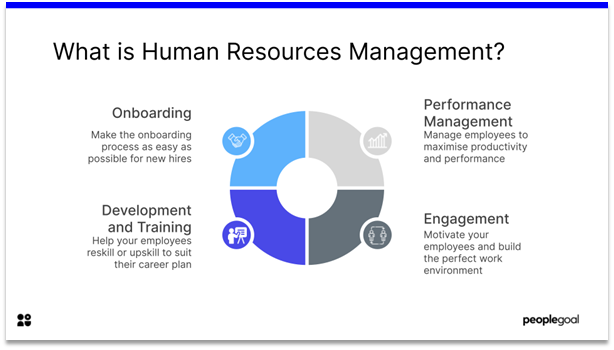More than half of the global workforce believes that we will have multiple jobs in the future. But with the labor market progressively characterised by short-term contracts, freelance work, flexible workforce and gig workers it will not come as a surprise.
What does the gig economy stand for
The gig economy refers to the increased interest of organizations to hire independent contractors and short-term workers as well as the growing number of freelancers and workers looking for temporary ‘gigs’.
Gig economy per se got its name from “each piece of work being akin to an individual ‘gig’”. Some gig jobs are based around technology platforms such as Deliveroo or Task rabbit while others are connected to more traditional jobs in companies that changed their operational structures. Meijerink and Keegan suggest that the gig economy can be defined as;
“An economic system that consists of intermediary platform firms that connect requesters (i.e. organizations or consumers) with on-demand gig workers in industries such as transportation (e.g. Uber), cleaning (e.g. Helpling), household do-it-yourself (e.g. TaskRabbit), and programming (e.g. Clickworker).”
Platform enabled gig work is the most common form of gig work. This refers to performance or fixed-term activities by workers for another individual or a company without being employed by the organization. Yet, gig work can also occur without the intermediary being present.
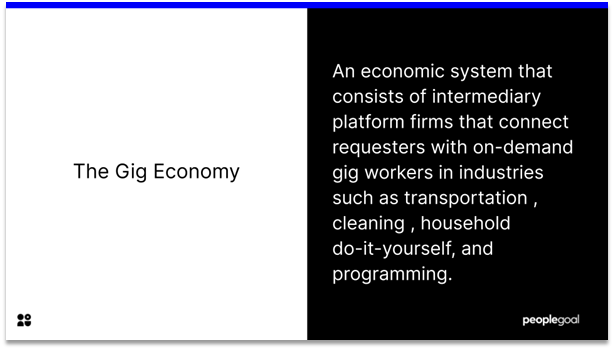
Gig workers rising
The term has emerged during the great recession to describe a growing number of individuals (regardless of the levels of their education), who held multiple part-time jobs, were employed by temporary agencies or freelanced. According to the Guardian Britain’s population of gig workers has reached 4.7 million workers in the UK, and 1 in 10 working-age adults work on gig platforms.
The main drivers behind the rose of this phenomenon included the great recession in 2008 as well as the millennials entering the job market. It brought a stream of young talent craving new experiences, willing to dispute one opportunity for another in a heart-beat. The gig economy provides young adults with a chance to experiment and experience various jobs in the form of part-time jobs and temporary gigs, resulting in higher turnover and lower loyalty.
In more traditional office and corporate environments, gig-style arrangements are often facilitated by recruitment or staffing firms, with workers taking short-term assignments through temp agencies. A clear understanding of how temping agencies work helps HR teams weigh up agency temps against platform-based contractors or direct hires, particularly when they need vetted, ready-to-start support at short notice.
Additionally, it meets the trends of desire for flexibility, independence and freedom of choice when it comes to collaborators, suppliers and other vendors.
On the contrary, the changing landscape of work pushes people to often accept gig work as it is their only chance for employment. In cases this less stable form of employment leads to insecurity and lack of stability.
With this in mind, it can be said that there are three main types of gig workers;
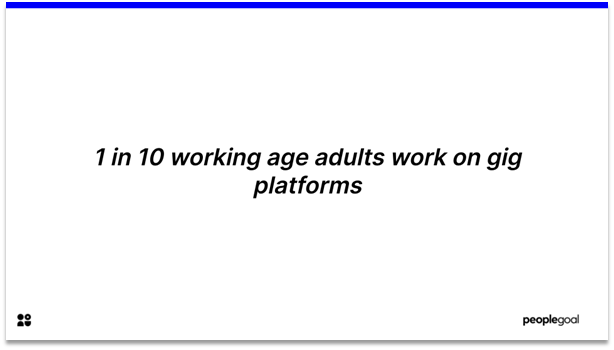
Types of gig workers
The Hobbyist
Harvard Business Review defines the hobbyist as a worker who is partially motivated by non-financial values and is commonly better prepared to take pay cuts. Such employees are for example drivers who choose to become taxi-drivers in retirement or in addition to their daily career for social reasons as well as the second salary and thus may contribute to income destabilization in an industry.
The Side-Hustler
A side hustler is an individual who takes on an extra job in addition to their full-time employment. A side hustler typically falls for the trend of gig work due to the financial aspect of “gig economy” or as an attempt to purse and monetize their passion. For many, it is also a sufficient way to dab into entrepreneurial waters without much risk.
The all-in player
An all-in player chooses the gig worker career as their main source of income. These workers enjoy the dynamic nature of gig economy and flexibility it brings to their life. Often these careers include IT sector, marketing or creative industries which are commonly known for freelancing.
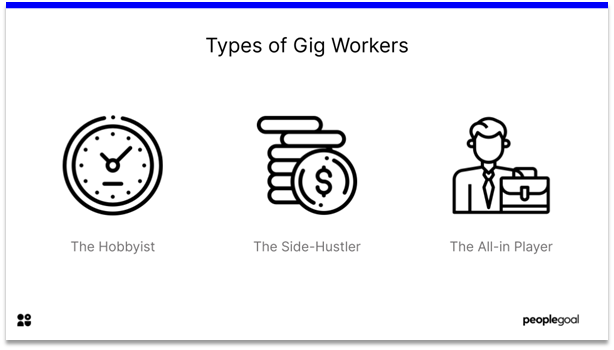
Gig economy pros and cons
In light of this, some of the main pros and cons of being a gig worker as well as for opting in for the services they offer include;
Pros
- Flexibility for workers
- Reduced entry and operating costs for ‘gig’ providers
- A chance to find purpose at work
- Work-life integration
- Faster hiring and onboarding
- Skill Based hiring
Cons
- Workers lack protection
- Workers are treated as disposable labor
- Lack of benefits (paid sick leave, health insurance, retirement benefits) for gig workers
- No notice period for the workers- they can be simply deactivated from the platform
- Lack of income security and the benefit of being affiliated with an organization and social support from fellow employees
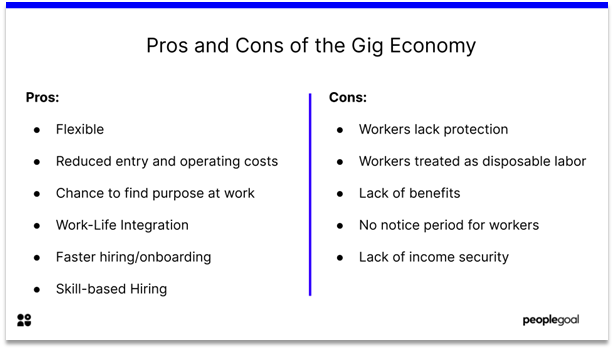
HR and a gig economy
The concept of gig workers removes the traditional employment between an employee and an employer. The challenge to HR is that each of the workers will have different rights, duties, benefits.
HRM activities to manage gig workers:
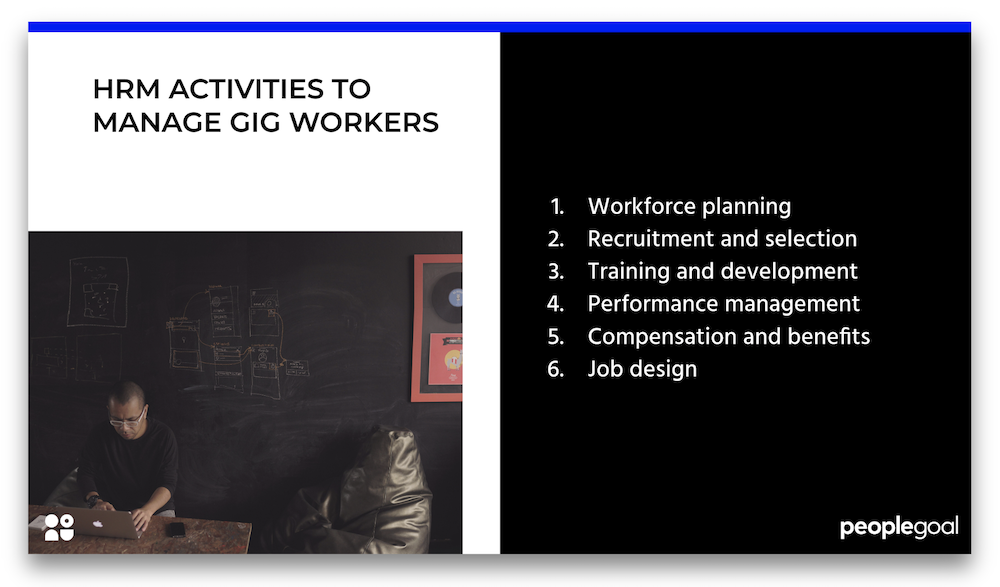
Workforce planning
Unlike in traditional employment, in gig economy, the workforce planning largely relates to matching the demand and supply for labor. Therefore, intermediary platforms
Recruitment and selection
Careful selection of gig workers can be a guarantee to of multilateral value to all parties involved. This is a case of such ‘gig’ that require a certain qualification or knowledge to successfully carry out the job.
Training and development
According to research, freelancers do not share the same levels of involvement in training and development as traditional employees. This is often also the case due to the fact they have to fund it themselves. On the other hand, the gig platforms often provide valuable information or training on such areas as how to improve customer ratings.
Performance management
Most commonly, the gig workers are evaluated thorough ratings of the requestor. Depending on if a gig worker only interacts with the customers or also with regular employees, the performance management is provided in a form of customer ranking or based on the client’s perceptions of the performance of gig worker. This provides an opportunity to generate feedback at least two ways; the perception of the customer as well as the requestor.
Compensation and benefits
The compensation normally takes a form of short term economic inducements. This needs to be seen as beneficial and appropriate by both parties to keep them engaged.
Job design
The rise of gig economy also affected the design of the jobs, thus human resources departments have to rethink the job offerings and responsibilities of these short term arrangements. Moreover, the legal attributes and regulations of gig economy remain challenging and need to be further addressed by the departments.
Gig workers management checklist
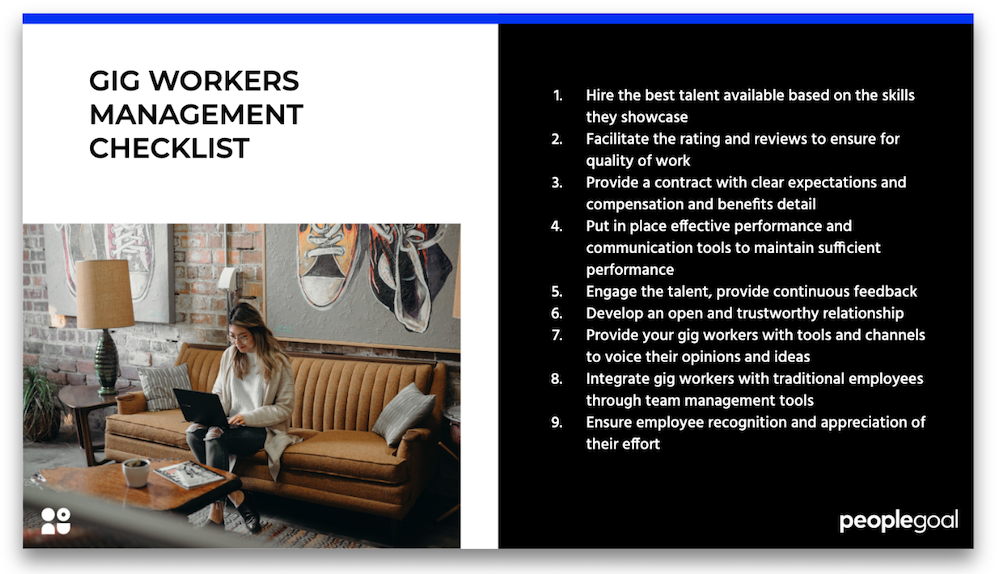
- Hire the best talent available based on the skills they showcase
- Facilitate the rating and reviews to ensure for quality of work
- Provide a contract with clear expectations and compensation and benefits detail
- Put in place effective performance and communication tools to maintain sufficient performance
- Engage the talent, provide continuous feedback
- Develop an open and trustworthy relationship
- Provide your gig workers with tools and channels to voice their opinions and ideas
- Integrate gig workers with traditional employees through team management tools
- Ensure employee recognition and appreciation of their effort
Ready to 3x Your Teams' Performance?
Use the best performance management software to align goals, track progress, and boost employee engagement.


